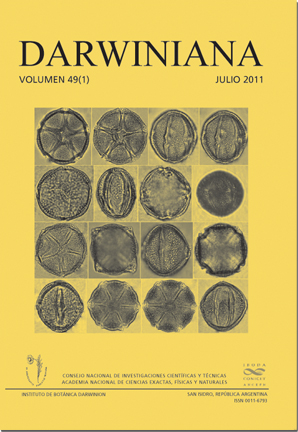Reproductive biology of Gomesa bifolia (Orchidaceae, Cymbidieae, Oncidiinae)
DOI:
https://doi.org/10.14522/darwiniana.2014.491.266Keywords:
Floral biology, oil-rewarding flower, Oncidiinae, reproductionAbstract
Gomesa bifolia (Orchidaceae, Cymbidieae, Oncidiinae) is an epiphytic orchid that presents showy yellow flowers with brown markings on sepals and petals, fragranceless and with oil as reward. The floral biology of this species was studied in cultivated individuals to describe phenology, flower longevity, reproductive system (using manipulative treatment of cross-pollination vs. self-pollination) and floral pollinators. Moreover, direct observations were made on plants exposed outdoors to identify pollinators, describing their foraging behavior and the duration of visits. The results showed that G.bifolia is a mainly self-incompatible, non-autogamous and pollinator-dependent species. The fruit set in manually cross-pollination flowers (100%) was higher than the manually self-pollinated flowers (30.8%), whereas the control flowers did not set fruits. Females of Centris trigonoides (Apidae, Centridini) were the exclusive pollinators, and the visit rate was low. Several Neotropical orchids of the subtribe Oncidiinae offer floral oils to the pollinators, like the Malpighiaceae familiy. Our results allow inferring that both groups of plants would be part of a guild of species pollinated by oil-collecting bees and that the deceit/pollination syndrome should not be applied to all Oncidiinae flowers.
Downloads
Published
31-07-2011
How to Cite
Torretta, J. P., Gomiz, N. E., Aliscioni, S. S., & Bello, M. E. (2011). Reproductive biology of Gomesa bifolia (Orchidaceae, Cymbidieae, Oncidiinae). Darwiniana, Nueva Serie, 49(1), 16–24. https://doi.org/10.14522/darwiniana.2014.491.266
Issue
Section
Reproductive Biology
License

Starting on 2012, Darwiniana Nueva Serie uses Licencia Creative Commons Atribución-NoComercial 2.5 Argentina .






